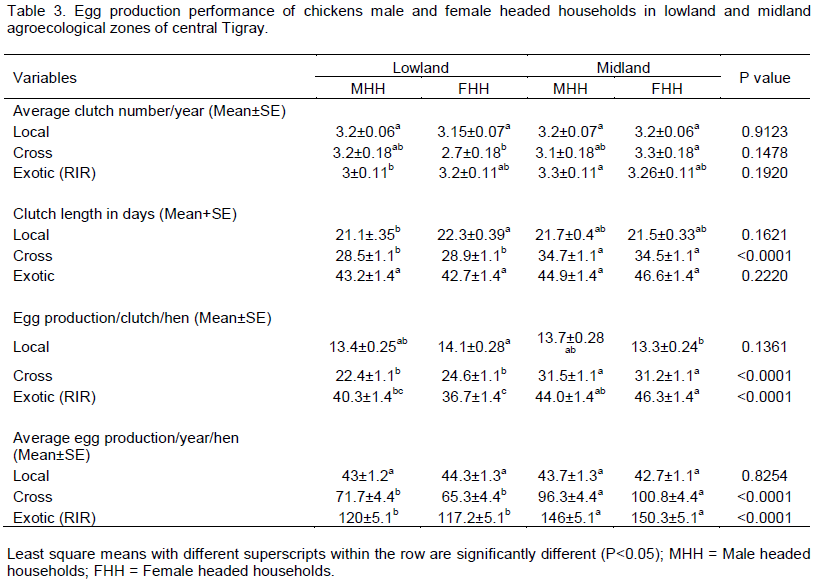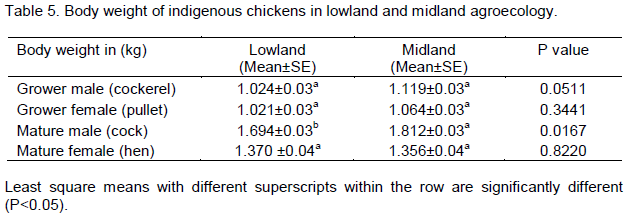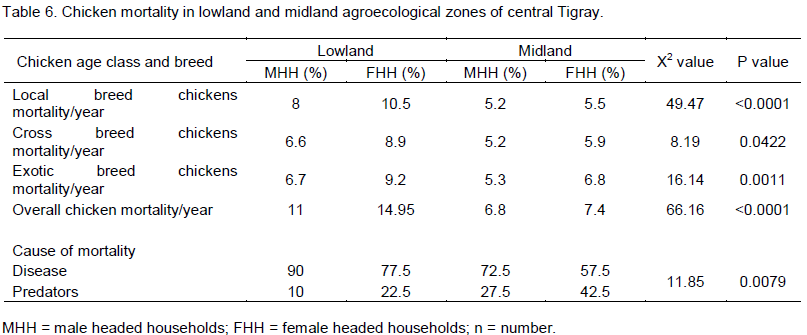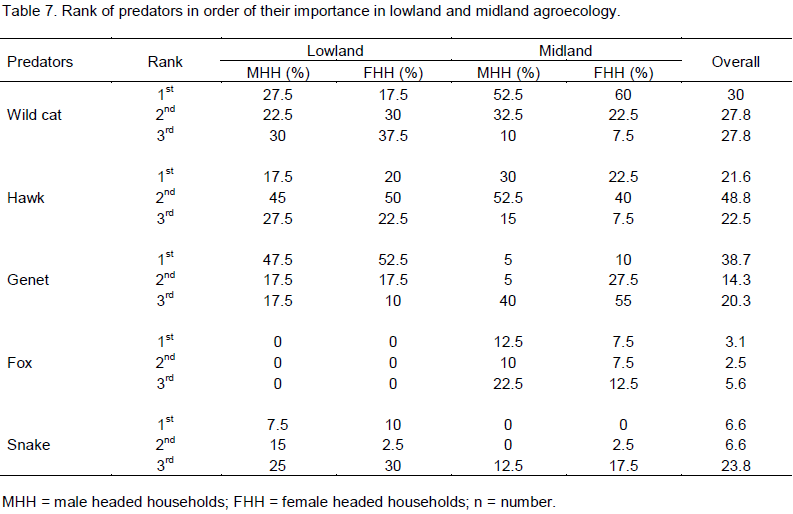Poultry production is an important sector in Ethiopia where chickens and their products are important sources of food and income. Ethiopian chickens are estimated to be over 56 million, and almost every family in the rural areas of the country practice traditional chicken production system (ILCA, 1993; Solomon, 2003). Poultry production systems in Ethiopia show a clear distinction between traditional, low input systems on the one hand and modern production systems using relatively advanced technology on the other hand (Alemu, 1995).
The chickens in free-range traditional poultry production systems are a function of natural selection which are mainly local or indigenous breeds. As a result the performance of chickens under rural conditions remain generally poor as evidenced by highly pronounced broodiness, slow growth rates, small body size and low production of meat and eggs (Kitalyi, 1998; Sonaiya, 2000; Gausi et al., 2004).
Even with its challenges, traditional poultry production, which is still important in low-income food-deficit countries, is an appropriate system to supply the fast-growing human population with high quality protein (Tadelle et al., 2003a). Moreover, indigenous chickens are known for their merits such as broodiness behavior with high fertility and hatchability, disease resistance thermo tolerant, good egg and meat flavor, hard eggshells, productivity at zero or minimal feed supplementation and high dressing percentage (Abera, 2000) that matches with the poor family poultry production systems. However, the indigenous chickens have been neglected in areas of scientific research on identifying distinct line breeds and its characterization, production performance, potential improvement and system development efforts.
Objective
1. To assess flock composition and flock dynamics of rural poultry production in male and female headed households in the lowland and midland agro-ecological zones in central Tigray.
2. To explore the production performance of rural chickens
3. To identify the major constraints and opportunities of rural poultry production in male and female headed households in the lowland and midland agro-ecological zones in central Tigray.
The study was conducted in central Tigray, Northern Ethiopia which is located between 13°15’ and 14°39’ North latitude, and between 38° 34’ and 39°25’ East longitude. Two sample districts, namely Adwa and Merebleke, were selected using systematic random sampling method. The study area (central zone of Tigray) was stratified into two agro-ecologies as midland and lowland based on their altitude and as customarily used by the local administration and bureau of agriculture. A total of 160 sample farmers, 80 from each district, 40 male and 40 female headed households were selected randomly using lottery method from those households reared at least one chicken in the year. Data like production and reproduction performance, hatchability, poultry loss and survival rate of chickens were collected using repeated farm recording methods and pre-tested formal semi-structured questionnaire. In addition four focus group discussions with an average group size of 16 individuals were conducted with key-informants (model farmers, elders, women association leaders, experts from Agriculture and Rural Development and Relief Society of Tigray office, administrative bodies, youths and extension workers) in both agro-ecological zones. Tape recorder was used to record the forwarded ideas during the group discussion. Statistical analysis were made using JMP5 (SAS, 2002). Descriptive statistics such as mean, range and percentile were used. Chi- square test was employed for ordinal and nominal data such as egg production, chicken loss and hatchability. ANOVA was also employed for continuous data type like body weight and sexual maturity.
Sexual maturity
Average age at first mating of cockerels was 26 weeks for local, 24.9 weeks for cross and 25.2 weeks for exotic breeds and there was no significant difference between lowland and midland agro-ecology (Table 1). A bit faster age of sexual maturity of cockerels (24.6 weeks) was reported by Fisseha et al. (2010) in North West Ethiopia, similarly Halima et al. (2007), reported that Pullets and cocks reached sexual maturity at an age ranging from 20 to 24 weeks Western Gojam. Kugonza et al. (2008) also reported that sexual maturity of male Chickens in Eastern Uganda was 5.5 months (22 weeks).

Average age at first egg was 27.2 weeks for local breeds ranged from 24 to 28 weeks, 25.7 for cross breeds ranged from 24 to 27 weeks and 25.4 for exotic breads ranged from 24 to 27 weeks. There was significant difference (P<0.05) on sexual maturity of both exotic, cross and local pullets between lowland and midland agroecology. Maturity of chickens was late in lowland than in midland agroecology. This might be attributed to the management practice like feeding, housing and health care of the farmers. Relatively better feeding and housing management was observed in midland agro-ecology. Sexual maturity of chickens always depends on chicken management and overall production systems of the households mainly on feeding and disease management practices.
This result was similar with 6.8 months reported by Tadelle et al. (2003b) and 6.5 months (26 weeks) reported by Kugonza et al. (2008) in Eastern Uganda but somewhat longer than the reported 5.9 months by Bogale (2008) in Fogera woreda and 168 days (24 weeks) by Benabdeljelil et al. (2001) in Morocco.
About 64.4% of the respondents had their own breeding cock and 71.1% of which were local breeds, 18.3% cross and 10.6% were exotic breeds (Rhode Island Red). Regarding source of cocks, 58.3% home grown, 31% purchased from market or neighboring farmers and the rest 10.7% received from GOs and NGOs (Table 2).
Egg production
With the same management practices of the households average number of eggs laid per hen per clutch was 13.6 for local hens ranged from 9 to 18 eggs, 25.7 for cross breed hens ranged from 15 to 35 eggs and 44.4 for exotic breeds ranged from 30 to 65 eggs (Table 3). Egg production of exotic breed and cross breed chickens was significantly higher (P<0.01) in midland than lowland. This difference could be due to the less resistance of these chickens to high temperature (40°C) in lowland which may affect their productivity. In addition the management level of the farmers may create difference in the production potential of the chickens, for example the management level and egg production of the households were positively correlated (r=0.53; n=160). This indicates that the low production and productivity of the chickens in the area is attributed to the poor management practice of the farmers. Similarly, Mwalusanya et al. (2004) reported that, the low productivity of chickens in Tanzania was partly due to the prevailing poor management practices, in particular the lack of proper health care, poor nutrition and housing.

The average number of clutches per year per hen was 3.2 for local hens ranged from 2 to 5 with an average clutch length of 21.6 days ranged from 15 to 28 days, 3.1 for cross breed hens ranged from 2 to 4 with an average clutch length of 31.6 days ranged from 18 to 40 days and 3.2 for exotic breeds with average clutch length 44.4 days.
Relatively small number of clutch per year (2 to 3) but longer clutch size (69 days) was reported by Kugonza et al. (2008) in Eastern Uganda. In addition 4 cycles of broodiness were recorded per year in hens with an average duration of 12 to 15 days per clutch in Kashmir (Iqbal and Pampori, 2008).
Clutch length in cross breed hens was significantly longer (P<0.001) in midland (34.6 days) than lowland agro-ecology (28.7 days). This result might be attributed to the difference in management practice of the farmers living in lowland and midland agro-ecology. As explained by the key informants in the group discussion, clutch number and clutch length of exotic breed hens were hardly identified by the farmers because, it was very difficult for the farmers to know whether the interruption of egg production is due to nature of the hen or shortage of feed because exotic breeds are sensitive to feed shortage. Average egg production per year per hen was 43.4 eggs for local hens, 81.4 eggs for cross breed hens and 144.3 eggs for exotic hens.
Egg production of exotic breed and cross breed chickens was significantly (P<0.01) higher in midland than in lowland. This could be due to the management level of the farmers and the high temperature in lowland by itself might have a negative effect on the production performance of the exotic hens. In line with this a study conducted at the College of Agriculture, Alemaya, has indicated that the average annual egg production of a native chicken was 40 eggs under farmer’s management (Tadelle et al., 2000) but higher egg production, 54.3 eggs/year/hen was reported by Abraham and Yayneshet (2010) for local hens and 185 eggs for exotic (Rhode Island Red) breeds similarly large number of eggs (78 eggs/hen/year) was reported by Benabdeljelil et al. (2001) for local hens in Morocco. From the result of this study, we can conclude that exotic and cross breed chickens can produce large number of eggs than local breeds mainly in midland agro-ecology in the presence of adequate amount of feed.
Hatchability and survival rate of chicks
In both agroecologies the average number of eggs set for incubation per broody hen was 10.2 eggs with hatchability of 85.8% for local eggs and 78.97% for cross breed eggs (Table 4). The hatchability of local and cross breed eggs was 82.5 and 72.5% in lowland areas and 88.9 and 85.5% in midland areas. This might be attributed to the high temperature in lowland that may affect the quality of the eggs and in addition broody hens would be restless during high temperature. This is in line with the reported 82.6% hatchability for local eggs in Bure wereda (Fisseha et al., 2010), 89.1% in Southern Ethiopia (Mekonnen, 2007) in addition, 90% of egg hatchability in Eastern Uganda (Kugonza et al., 2008), and 83.6% hatchability in Tanzania was reported by Mwalusanya et al. (2004) but higher than the reported 70.5% hatching rate (Tadelle et al., 2003b) and 78.6% hatchability of local eggs reported by Abraham and Yayneshet (2010) for Northern Ethiopia, 61.8% hatchability in Botswana (Aganga et al., 2000) and the hatchability ranged 77 to 81% in Kashmir (Iqbal and Pampori, 2008). This variation might be due to the difference in management practices of the poultry producers in the different climatic zones. Chicks reached grower stage 8 weeks (survival rate) were 65.8 and 63.7% for local and cross breed chicks, respectively. There was significant difference (P<0.05) in survival of local and cross breed chicks between lowland and midland agro-ecology. This could be due to the difference in disease prevalence rate and management practice of the farmers in the area. This is lower than the reported 75% of the chicks survived the brooding period in Sudan (Khalafalla et al., 2001), but higher than the reported 60.5% of birds reached grower stage in Bure wereda (Fisseha et al., 2010), 51.3% average survival rate of chicks in Ethiopia (Tadelle et al., 2003b) and about 44.2 % mortality of chicks (55.8 % survived) reported by Abraham and Yayneshet (2010) for Northern Ethiopia. In addition, the overall mean chick survival rate to 10 weeks of age in Tanzania was 59.7% (Mwalusanya et al., 2004).

Body weight of indigenous chickens
The average weight of mature males (cocks) was significantly higher (P<0.05) in midland (1.812) kg than in lowland (1.694) agro-ecology (Table 5). But similar body weight of hens (1.37 kg and 1.356 kg), cockerels (1.024 kg and 1.119 kg) and pullets (1.021 kg and 1.064 kg) was recorded in lowland and midland agroecology, respectively. The substantial differences in body weight observed for the different classes could be attributed to non genetic factors like supplementary feeding, watering and health care. The average weight of mature males (cocks) in this study is higher than the average weight (1.5 kg) of the indigenous chicken of the Central Highlands of Ethiopia (Alemu and Tadelle, 1997) and lower than the mean weight (2049.07 g) of indigenous chicken in Northwest Ethiopia (Halima et al., 2007). Moreover the reported mean weight of mature male (1.6 kg) and female (1.3 kg) chicken in Southern Ethiopia was lower than this result but the mean weight of grower male (1.05 kg) and female (1.04 kg) chicken in that area (Mekonnen, 2007) was similar to this result.

Poultry loss
In fact feed shortage, accidents and theft could play a considerable role in poultry loss but high chicken mortality has always occurred at time of disease outbreak and predators in both agroecological zones as mentioned by the key informants in group discussion. According to the interviewed farmers in the study area hatchability was high but eventually they left with two or three birds reached matured age. When farmers were asked to rank the major causes of high mortality in their locality 90% of male and 77.5% of female headed households in lowland and 72.5% of male and 57.5% of female headed households in midland agroecology ranked disease as first major cause of chicken loss whereas the rest 10% of male and 22.5% of female headed households in lowland and 27.5% of male and 42.5% of female headed households ranked predators as first cause of chicken loss (Table 6). Disease followed by predators as major causes of chicken loss in the study area is in agreement with that reported by Halima et al. (2007) in North West Ethiopia and Abdelqader et al. (2007) in Jordan. Similarly in Morocco as reported by Benabdeljelil et al. (2001) high mortality was recorded as a result of diseases and predators (mortality rates reached up to 77%) and in Uganda predators and diseases were responsible for the high mortality of chicks (Illango et al., 2002.). Muchadeyi et al. (2004) also reported that Predation and diseases were said to be the major causes of mortality in Rushinga District of Zimbabwe.

Average annual mortality of chickens was 10. Mortality was significantly high (P<0001) in lowland (12.96) than in midland (7.05). This could be attributed to the high prevalence of disease in lowland areas and poor management practices of the farmers mainly their housing system which was easy for predators attack. There was also significant difference (P<0.05) between male headed and female headed households in chicken mortality. This of might be attributed to the difference in management system like housing, feed supplementation and cleaning rate chicken house. The study also revealed that average annual mortality of chicks was 3.98 for local, 3.7 for cross breed and 3.2 for exotic breed chicks (Table 6). Mortality of exotic breed chicks was relatively lower than the local and cross breeds. This could be attributed to the vaccination given to the chicks before the time of distribution which may help them in acquiring resistance against prevalent disease in the area hence, exotic breed chicks were hatched in hatchery machine and distributed to beneficiaries after 5 or 7 days old by governmental or none governmental organizations. Average mortality of growers (birds with 2 to 6 months of age) was 1.97 per year for local birds, 2.3 for cross breeds and 2.2 for exotic breeds.
Annual matured chicken (birds > 6 months) mortality was 1.3 for local birds, 1.2 for cross breed birds and 2.1 for exotic breed chicken. In general average mortality of local, cross and exotic breed chickens was 9.25, 7.8 and 7.8 chickens/year in lowland and 5.3, 5.5 and 6.1 chickens/year in midland agroecology, respectively. According to the interviewed farmers high mortality always occurred at the end of dry season mainly from March to June. High temperature and moisture in this season may create a favorable condition to bacterial and/or viral disease outbreak resulted in high chicken mortality. Similarly Swatson et al. (2001) reported that poor protection from adverse climatic conditions (very hot and cold weather) increased the severity of disease outbreaks resulting in losses of up to 70% of the flock at 12 weeks of age.
Predators
Predators were the major causes of year round losses of chickens in both agroecological zones. About 42.5% of female headed households in midland agro-ecology indicated that highest loss of chicken was from predation (Table 7). The most common predators mentioned by the farmers were Wild cat, Hawk, Genet, Snake and fox in their order of importance. Although all those predators were mentioned by the farmers as main causes of chicken loss, their order of importance varies with season and agro-ecology. For example hawks were the problem of households living in open and more plane areas both in lowland and midland agro-ecology mainly in dry season and were mentioned as important predator by 21.6% while wild cat and genet were more prevalence predators caused high loss of chickens at the end of rainy season, mentioned by 22.5 and 50% of the households in lowland and 56.25 and 7.5% of the households in midland agroecology, respectively. Snakes were common predators in lowland areas whereas foxes were a problem of those households living on hillside and nearby to enclosure areas in midland agro-ecology. According to the respondents hawks attack chicks in the dry season but other predators attack all age class of the chickens mainly during rainy season because the predators can hide themselves around the backyard in the bush or shrub. In line with this, losses of chickens in Nigeria were attributed mainly to predators (Sonaiya, 2006). Similarly in morocco causes of mortality in poultry other than diseases were predators and accidents (Faouzi et al., 2002).

When farmers were allowed to prioritize the more affected breed type by predators, 45 and 40% of the households in low land and midland agro-ecology respectively said that all breeds were affected equally whereas 55 and 60% of the households in lowland and in midland agro-ecology respectively mentioned exotic breed as more attacked or sensitive group. According to these farmers unlike local chickens exotic breeds are not fast and active to escape away from predator’s attack. Farmers in the study area always tried to prevent their chickens from predator attack using different mechanisms like killing the predator using foxhound, but also constructing houses and keeping the chickens in house could be a solution to reduce chicken loss due to predators.
Diseases
Seasonal and recurrent disease outbreak was the major cause of poultry loss in both agroecological zones of the study area. The study revealed that 87.5% of the households in lowland and 68.75% in midland experienced with chicken disease in the past one year (2011 - 2012). According to the animal health experts (veterinarians) in Agriculture and Rural Development office of Adwa woreda and Mereb-leke district, even though many bacterial and viral diseases like Salmilosis, Fowl typhoid and fowl pox were important diseases in the area, ND was the most devastating disease and considered to be a major constraint to the development of poultry production in the area. Similarly Halima et al. (2007) reported that, the major causes of death for local chicken ecotypes in North-West Amhara were seasonal outbreaks of chicken diseases, specifically Newcastle disease. Newcastle disease (ND), called Fengil in Ethiopia, is reported to be the most important cause of economic loss in poultry production (e-Newsletter, 2006).
Swatson et al. (2001) also reported that about 75% of respondents in South Africa indicated that Newcastle is the major disease that wipes out 85% of their flocks. Most farmers living in lowland areas of the study area do not give any name for the disease affecting their chickens, they simply called ‘Disease’ (locally called Himam) but they can easily identify the symptoms of the disease. In midland agro-ecology, however, farmers locally called kudm for Newcastle disease and expressed the symptoms in different ways. For example gastrointestinal disorders like diarrhea with greenish, yellowish and blood stained excreta, nasal discharges, twisted neck, dropping of wings, inability to drink and eat properly (jine malet) and sudden death were some of the symptoms mentioned by the farmers. They have also indicated that, the disease mostly occurs at the end of dry season and beginning of rainy seasons particularly from March to June.
According to the animal health experts in both agroecologies these symptoms are referring to Newcastle disease. The interviewed chicken owners revealed that the disease affected all chicken breeds and age groups. About 37.5% of the households in lowland and 30% in midland indicated chicks (< 2 months) as more affected age groups, 41.2% of the households in lowland and 33.75% in midland reported matured lying and incubating hens as more sensitive chickens to disease while the rest 21.2% of the households in lowland and 36.2% in midland mentioned all age group as equally affected chickens by disease (Table 8).
Regarding to breed groups, 83.75 and 71.2% of the households in lowland and midland agroecology, respectively indicated that exotic chicken breeds were more sensitive and easily affected by disease.
According to the veterinarian in Adwa and Mereb-leke districts, except for exotic breeds that were immunized against Newcastle disease before distribution, there was no regular schedule of vaccination service for local chickens but at time of wide spread disease outbreak, ring vaccination method could be practiced to control the outbreak.